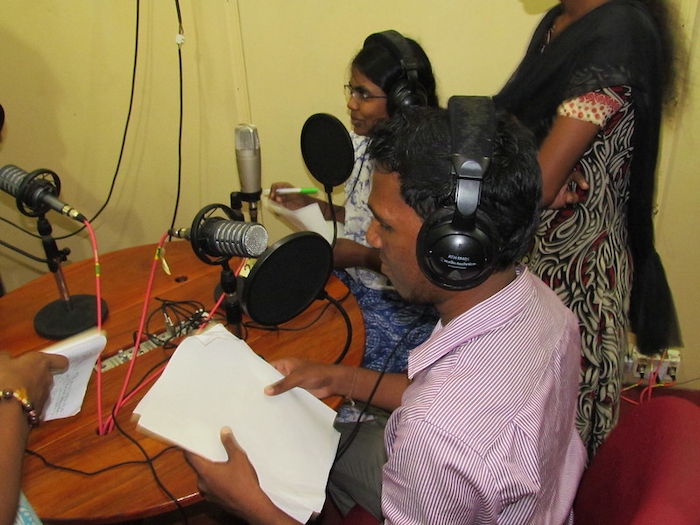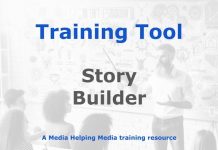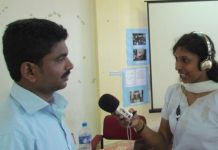
This is a short training module setting out the basics for creating a news package for radio. It’s been created for those starting out in radio journalism.
Technique: Using sound to tell a story
Think of your voice as the primary instrument in your storytelling. It is not just about conveying information; it is about creating an intimate connection with the listener.
- Imagine your voice going into a listener’s ear, painting pictures and evoking emotions. The voice is the main vessel for tone and emotion before the actuality begins.
- Use your voice expressively – plenty of variation in pace, tone, and inflection to match the narrative. A sombre story demands a different vocal approach than a celebratory one.
- Crucially, vary your pace to match the pacing of the sound clips you are linking.
- The tone should be sympathetic to the story. Authenticity is important; let your voice reflect the genuine emotion of the story.
- Maintain conversational warmth—avoid the overly formal or “reading news” tone.
Best practice: Voice clarity and projection Ensure your voice is recorded clearly. Use a high-quality microphone and understand how distance affects projection; speaking too close can cause distortion, too far can sound thin.
Actuality: The voice of reality
Actuality, the recorded sound of events and voices, is the lifeblood of audio news. It is what separates radio from print. Do not just tell the story; let the listener experience it.
- Actuality enriches your script. It provides credibility and emotional punch that narration alone cannot deliver.
- Find good people to interview who can offer unique insights and perspectives.
- Prioritise passion and clarity over a mere title; a heartfelt, articulate witness is often better than a formal spokesperson.
- Look for complementary sounds which are relevant to the story (the “soundscape” of your story).
- If it is a story about dogs, you need barking, but also consider the sounds of a dog park, a lead jingling, or even the soft panting of a contented canine. These details bring the story to life.
Best practice: The ethics of recording: Always seek explicit permission before recording anyone, especially for broadcast. Inform interviewees how the audio will be used. Be prepared to record actuality without speaking over it to ensure you capture clean, usable sound.
Chronology: The narrative arc
A compelling news package follows a clear narrative arc. Understanding the evolution of the story and the chronology of events is crucial.
- Find out what has happened by establishing the core facts. Frame the story clearly in the opening: What is the current state?
- Uncover the who, why, when, where, and how of the story. Go beyond the surface. Uncover the why – the motivations, the context, the underlying issues. The “why” is often the most engaging part of the narrative.
- Ensure you understand fully all the elements. This thorough understanding allows you to guide the listener through the unfolding narrative, preventing confusing jumps in time or logic.
- Use signposts (e.g., “Earlier that day…”, “Since then…”) to help the listener track the timeline.
Best practice: The three-act structure: Consider the standard story structure: Setup (introduces the people/place and problem), Conflict/Rising action (the main challenge and attempt to solve it, using most of your actuality), and Resolution/Conclusion (the current status and the “so what?” factor).
Atmosphere: Painting with sound
Wild track, or ambient sound, is more than just background noise; it is the atmosphere that immerses the listener in the story.
- Record enough wild track at the scene. Aim for a minimum of two minutes of clean background sound to give flexibility in editing.
- Wild track is background noise (the murmur of a crowd, the rustle of leaves, the hum of traffic). It establishes the environment and helps mask edits.
- It’s useful because you may need it later in the editing process, allowing you to create smooth transitions, establish location, and enhance the overall listening experience.
- Think of wild track as the sonic equivalent of establishing shots in film.
Best practice: Dealing with room tone and silence: Understand the difference between wild track (scene-specific sounds) and room tone (the sound of a specific, quiet indoor space). Both are vital for continuity. Never use pure digital silence, as it feels abrupt; always layer in a continuous, low-level atmospheric track.
Sensing: Immersive storytelling
Go beyond simply reporting; transport the listener to the scene. Describe what you are sensing – the sights, sounds, smells, and even textures.
- At the scene, explain what you are sensing. Use vivid, descriptive language that appeals to the listener’s imagination.
- Describe what you can see, hear, smell and touch. For sound, differentiate between specific sounds (a slamming door) and the general atmosphere (a constant, low industrial hum).
- Avoid explaining how YOU are feeling. While your personal feelings are less important, your observations are crucial.
- These sensory details ground the listener in the reality of the story.
Best practice: Show, don’t tell: Instead of saying, “It was cold,” describe the visual or audible evidence: “The vendor stamped his feet to shake the chill, and condensation bloomed on the cold metal railings.” This makes the description active and sensory.
Feeling: The emotional core
While your personal feelings are secondary, the emotions of those involved are paramount. Seek out the emotional core of the story.
- Ask your interviewees what they feel. Frame questions in an open-ended way: “Can you describe what that moment felt like?”
- Find out if they are afraid, sad, hopeful, happy. Their authentic emotions resonate with listeners and create a powerful connection.
- What YOU feel doesn’t matter. Do not be afraid to ask direct questions about their feelings, but do so with empathy and sensitivity.
- Listen actively and be comfortable with silence; it often leads to the most powerful and honest answers.
Best practice: Emotional arc: Look for an interviewee who can articulate not just a single emotion, but an emotional arc – how they moved from fear to hope, or from sadness to determination. This makes their contribution dynamic and relatable.
Perspectives: A tapestry of voices
Strive for fairness by presenting multiple perspectives.
- Seek out multiple perspectives and diverse voices, even those that conflict with your own or the dominant narrative.
- Look for diverse voices. Actively seek out marginalised voices and perspectives that might otherwise be overlooked. This adds depth and integrity to your reporting.
- Never ignore conflicting opinions. Presenting conflicting opinions is not about creating false equivalence; it is about providing context and allowing the listener to draw their own conclusions.
- Ensure you attribute all opinions clearly so the listener knows whose perspective they are hearing.
Best practice: Layered sources: Beyond the main interviewee, look for “third-party experts” or academics who can provide essential context and verify claims, adding authority to the conflicting perspectives you present.
The “so what?” factor: Relevance and impact
Every news story should answer the fundamental question: “So what?” Why should the listener care? Explain the implications of the story and its potential impact.
- Find out what are the next steps. What is the call to action, or the immediate consequence of the events?
- Explain why those steps are important. Tie the micro-story (what happened to one person) back to the macro-issues (why this affects the community or policy).
- Note any future events & meetings for follow up purposes. This provides closure and demonstrates the ongoing relevance of the story. The conclusion should look forward, not just summarise the past.
Best practice: Making it personal: Conclude by personalising the impact. Instead of saying, “It will cost the local council money,” say, “This means local residents will see a delay in repairs to their bridge for at least six months.”
Putting it together: The art of audio weaving
Crafting a compelling news package is like composing a piece of music. You are weaving together different elements – interviews, wild track, your narration – to create a cohesive and engaging whole.
- Use short clips from your wild track and interview. Use short, impactful clips.
- Aim for soundbites that are 10–20 seconds; anything longer risks losing the listener’s attention.
- Use your script to bind them together in a logical way, providing context and narrative flow.
- Keep your links short and focused. They should seamlessly bridge between the actuality and the ambient sound, guiding the listener through the story. Editing is crucial.
- Never repeat information in your link that the actuality clip has just provided.
Best practice: Pace and rhythm: Focus on the rhythm of the package. A sequence of short soundbite, short link, short soundbite can feel choppy. Vary the pace by having a longer section of narration followed by a powerful, sustained sound effect or interview clip.
A well-crafted package is more than just a collection of sounds; it’s a story told through sound, engaging the listener’s imagination and leaving a lasting impression.

Questions
- What is the role of voice in storytelling according to the text?
- How can actuality enhance a script?
- Why is it important to find complementary sounds relevant to the story?
- Describe the significance of chronology in storytelling.
- What is the purpose of recording wild track at a scene?
- How should a storyteller convey their sensory experiences at a scene?
- Why is it important to focus on the interviewees’ feelings rather than the storyteller’s own emotions?
- Explain the importance of seeking multiple perspectives in storytelling.
- What is the “so what factor” and why is it crucial in storytelling?
- How can a storyteller effectively integrate wild track and interview clips into a cohesive narrative?
Answers
- The role of voice in storytelling is to use it expressively with plenty of variation, ensuring the tone is sympathetic to the story.
- Actuality enriches a script by providing real-life sounds and voices that add authenticity and depth to the narrative.
- Complementary sounds are important because they enhance the realism and engagement of the story, making it more relatable and vivid for the audience.
- Chronology is significant because it helps in understanding the evolution of the story by uncovering the who, why, when, where, and how.
- Recording wild track is useful because it provides background noise that can be used later in the editing process to create a more immersive atmosphere.
- A storyteller should convey their sensory experiences by describing what they see, hear, smell, and touch, without focusing on their personal feelings.
- Focusing on the interviewees’ feelings is important because it provides an authentic emotional impact and perspective, which is more relevant to the story.
- Seeking multiple perspectives is important to ensure a balanced and comprehensive narrative that includes diverse voices and opinions.
- The “so what factor” involves explaining the next steps and their importance, ensuring the story has relevance and a clear direction for future developments.
- A storyteller can effectively integrate wild track and interview clips by using a script to bind them together logically, keeping the links short and coherent.
Related material








